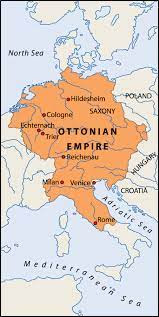Romuald (c. 950 - 1025/27) was born in an aristocratic family in Ravenna, in northeastern Italy. An indulged and indulgent youth, at the age of 20 his life changed when he was his father's second in a duel. Seeing his father win the duel—in which he killed a relative over a property dispute—changed the young man. Romuald did 40 days of penance for his part in the affair, and became a monk at the Basilica of Sant'Apollinare in Ravenna.
Although his location followed the Cluniac Order, Romuald wanted something more strict, and he raised the ire of his comrades by criticizing their excesses and lapses. He was given permission to leave the monastery; he went to live under the guidance of a strict hermit in Venice.
In a parallel to Romuald's turning point, we turn to the doge of Venice in 978, Pietro I Orseolo. Pietro had taken the position after being involved in a conspiracy to overthrow his predecessor, Pietro IV Candiano. Orseolo, feeling remorse for his actions two years earlier, left Venice in the middle of the night without telling anyone, not even his family, and went with Romuald and others to join the Benedictines at at Saint-Michel-de-Cuxa in southern France.
Over the next several years, Romuald refined his ideas of monasticism, then spent 30 years traveling Italy and preaching the benefits of a strict monastic life, founding and reforming monasteries. An attempt to be abbot at the Basilica of Sant'Apollinare on the invitation of Holy Roman Emperor Otto III failed, since the monks objected to his reforms.
In 1012 he arrived in Arezzo, where he was given land in Camaldoli, upon which Romuald built five hermit cells; these and a monastery built two years later became the motherhouse for the Camaldolese Order.
Romuald's idea of a proper life was laid out in his rule, entitled "Empty yourself completely and sit waiting." His central advice for monks and hermits was:
Sit in your cell as in paradise. Put the whole world behind you and forget it. Watch your thoughts like a good fisherman watching for fish. The path you must follow is in the Psalms — never leave it.
There are a dozen locations that are part of the Camaldolese Congregation totaling several dozen members.
Before settling in Arezzo, Romuald stayed for a time in Vallombrosa. Years later, a monk stayed at Camaldoli for awhile, and then started his own congregation at Vallombrosa. The next-oldest member of the Benedictine Confederation is the Vallombrosian Congregation, and we'll see what makes them different tomorrow.




